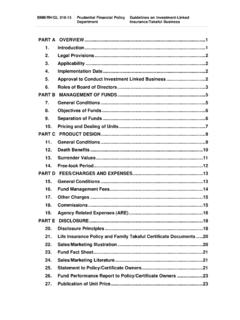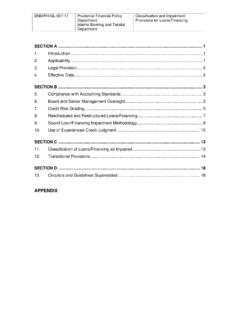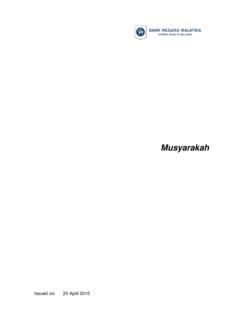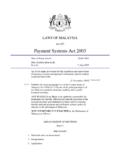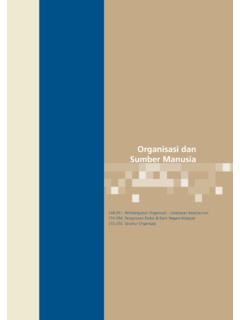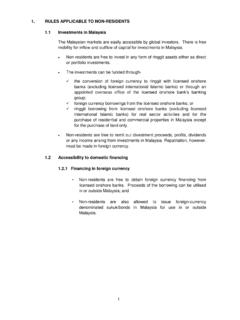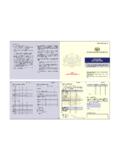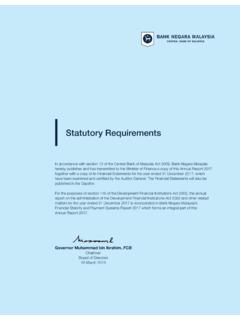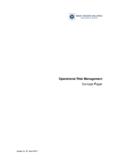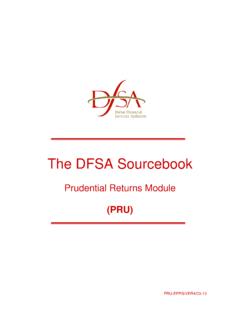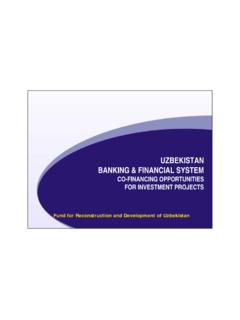Transcription of STATUTORY REQUIREMENTS - Central Bank of …
1 STATUTORY REQUIREMENTS . For the period January 2013 to June 2013, for purposes of section 192 of the Insurance Act 1996 and section 56 of the Takaful Act 1984 (respectively repealed by the financial Services Act 2013 and the Islamic financial Services Act 2013. with effect from 30 June 2013), Bank Negara Malaysia has submitted to the Minister of Finance a copy of this financial Stability and Payment Systems Report 2013. for presentation to Parliament. Zeti Akhtar Aziz Governor 19 March 2014. PREFACE. The financial Stability and Payment Systems Report 2013 outlines Bank Negara Malaysia's assessment of risks and challenges faced by the Malaysian nancial system and the capacity of the system to sustain its nancial intermediation role in the economy.
2 It also reports the developmental initiatives pursued by the Bank to reinforce the roles of the nancial services sector in supporting and contributing to economic growth and the economic transformation process, as well as the regulatory and supervisory measures undertaken by the Bank to ensure continued safety and soundness of nancial institutions and promote overall nancial and payment systems stability. This publication is intended to promote greater understanding on issues and developments affecting nancial stability, including policy directions of the Bank. The financial Stability and Payment Systems Report is available in PDF format at Contents GOVERNOR'S STATEMENT. EXECUTIVE SUMMARY.
3 financial Stability Report RISK DEVELOPMENTS AND ASSESSMENT OF financial STABILITY IN 2013. 13 Overview 15 Managing Risks Arising from Household Indebtedness 21 Managing Developments in the Domestic Property Market 22 Box Article: Credit Expansion and Implications on financial Stability 33 Managing Credit Risk Exposures to Businesses 36 Managing financial Market Volatility and Contagion Risk from External Exposures and Overseas Operations 46 Box Article: External Connectivity and Risk of Contagion to the Malaysian Banking System 54 Interlinkages of the Banking System with Non-Bank financial Institutions (NBFIs). 57 financial Institution Soundness and Resilience 65 Outlook for Domestic financial Stability and Focus of Surveillance in 2014.
4 DEVELOPMENT OF THE financial SECTOR. 69 Ensuring Effective and Ef cient Intermediation 71 Box Article: Developing the SME Financing Ecosystem 77 Strengthening the Insurance and Takaful Industry 78 Box Article: Reforms in the Life Insurance and Family Takaful Industry 80 Promoting an Inclusive financial System 81 Developing Deep and Vibrant financial Markets 84 Enhancing Malaysia's Interlinkages with Regional and International Economies 85 Malaysia as an International Islamic Finance Marketplace 87 Box Article: Diversi cation of Islamic Banking Business and Products Driven by Shariah Contracts 92 Continued Development of Human Capital 94 Key Priorities Moving Forward REGULATORY AND SUPERVISORY FRAMEWORK.
5 97 Strengthening the Prudential Framework 103 Safeguarding the Integrity of the financial System 106 Box Article: Strengthening the Anti-Money Laundering and Countering the Financing of Terrorism (AML/CFT) Framework MARKET CONDUCT AND CONSUMER EMPOWERMENT. 113 Key Trends and Developments 114 Regulation and Supervision of financial Service Providers 116 Managing Risks to financial Consumers 120 Collaboration with Other Agencies 120 Well-Informed and Responsible financial Consumers 122 Strengthening Avenues for Consumer Redress Payment Systems Report PAYMENT AND SETTLEMENT SYSTEMS. 127 Promoting the Stability of Payment and Settlement Systems 130 Key Developments in Payment Systems 134 Moving Forward 135 Box Article: Accelerating the Migration to Electronic Payments ANNEX.
6 GOVERNOR'S STATEMENT. The domestic nancial system remained resilient in 2013 with signi cant progress achieved on a number of important fronts to strengthen the conditions for nancial stability. As an open economy, Malaysia experienced signi cant two-way capital ows following the continued volatility in the international nancial markets. The effects have however been relatively modest re ecting a far more resilient domestic nancial system. The orderly conditions in the domestic nancial markets was supported by the deeper and more developed domestic nancial markets which was further reinforced by the presence of a large number of strong domestic institutional investors. financial institutions in Malaysia also continue to demonstrate a high degree of resilience during the year.
7 Among the signi cant developments during the year were several legislative, structural and institutional enhancements in the nancial sector. This included the coming into force of the financial Services Act 2013 and Islamic financial Services Act 2013 in June which, together with the Central Bank of Malaysia Act 2009, takes the legislative framework for nancial stability in Malaysia to a new frontier. This re ects and anticipates a nancial system that is more dynamic, more interconnected and inclusive but also more complex. The legislation signi cantly strengthens the Bank's capacity to maintain nancial stability in this changing environment and in many ways, places Malaysia at the forefront of nancial stability frameworks.
8 This strengthened capacity has enabled the Bank to respond to the potential build up of nancial imbalances in an environment in which credit has continued to expand at a relatively strong pace in particular to the household sector, while asset prices experienced upward pressures. The Bank expanded the use of macroprudential instruments including to the non-bank sector to secure stable conditions in the credit and asset markets, in addition to maintaining a strong supervisory focus on the lending and provisioning practices of the banking institutions. Maintaining con dence in the nancial system has also involved protecting the system from abuse. Actions against nancial crime both preventive and enforcement actions continued to be pursued to safeguard the integrity of the nancial system.
9 This included the steps taken to review and strengthen the Anti-Money Laundering and Anti-Terrorism Financing Act 2001 (AMLATFA), while the enforcement actions have also been more effective including with stronger domestic and international cooperation. Prudential standards have also continued to be raised, most notably with the implementation of the Basel III. reform package beginning from January 2013. At the same time, the greater maturity of the nancial sector has allowed the Bank to pursue important reforms to further reduce pricing distortions, including in the motor and life insurance industries, and in respect of payment instruments. Progress has also been made in the plans to replace the base lending rate framework with a new reference rate framework that is more relevant and re ective of conditions in the funding markets.
10 These developments reinforce the progress in evolving a greater degree of market orientation in nancial services that would in turn, contribute to the ef cient and effective overall functioning of the nancial sector. Finally investment in talent development for the industry has remained a key priority. The efforts have culminated in three further strategic initiatives - the establishment of the National Talent Council, the Finance Accreditation Agency and the financial Services Professional Board, which is being led by the industry, to raise the bar in the nancial services industry. On the regional front, Asia as a whole has continued to become more cohesive. Regional nancial integration has gained further traction during the year with the ASEAN Banking Integration Framework now in its nal stages.
